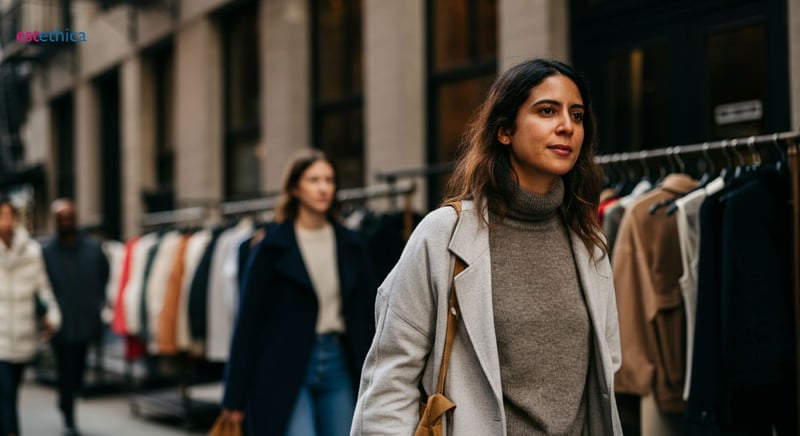Discover estethica: Redefining Sustainable Fashion
Dive into the world of sustainable fashion with estethica's forward-thinking approach to eco-friendly and ethical clothing.
Sustainable fashion is becoming more than just a trend; it’s evolving into a pivotal movement that combines style, purpose, and eco-consciousness. As consumers become more aware of the environmental impact of their wardrobe choices, brands like estethica are stepping up to redefine what it means to be fashion-forward yet environmentally responsible. This article will venture into the heart of sustainable fashion — from understanding its core principles to choosing eco-friendly clothing with confidence. We will spotlight ethical fashion brands you can trust and navigate the world of green and circular fashion, aligning aesthetics with environmental ethics.
Understanding the Core of Sustainable Fashion
Exploring the Aesthetics of Sustainable Fashion
Sustainable fashion is not just about reducing environmental impact; it also embraces aesthetics that appeal to the modern consumer. The prime aesthetics of sustainable fashion focus on timeless designs that transcend fleeting trends, ensuring garments remain stylish and relevant. For instance, a classic white organic cotton shirt can be a staple in any wardrobe, offering both elegance and sustainability. Elite aesthetics in sustainable fashion often involve innovative designs that use upcycled materials, transforming waste into wearable art. This approach not only reduces waste but also adds unique character to each piece, making them stand out in the fashion world.
Key Elements of Eco-Friendly Clothing
- Use of organic materials like cotton, which require less water and pesticides.
- Implementation of ethical labor practices ensuring fair wages and safe conditions.
- Focus on quality over quantity to extend garment lifespan and reduce replacements.
These elements contribute to the aesthetics beauty of sustainable fashion, where each piece is crafted with care and consideration for both people and the planet.
Steps to Choose Sustainable Fashion
- Research brands that prioritize eco-friendly practices and ethical labor standards.
- Look for certifications like Fair Trade or GOTS to ensure authenticity.
- Prioritize quality and timeless designs over fast fashion trends.
By following these steps, consumers can make informed choices that align with their values and contribute to a more sustainable future. For more insights on sustainable practices, you can explore estethica's Expert Insights.

Choosing Eco-Friendly Clothing with Confidence
Identifying Ethical Fashion Brands
To confidently choose eco-friendly clothing, it's essential to identify ethical fashion brands. These brands prioritize sustainability and transparency in their operations. For example, a brand that uses organic fibers like hemp and bamboo demonstrates a commitment to reducing water and chemical usage. Additionally, brands that adopt zero-waste patterns and use recycled materials showcase their dedication to sustainable production methods. By focusing on these aspects, consumers can align their fashion choices with their values, ensuring they support brands that contribute positively to the environment.
Evaluating the Cost of Eco-Friendly Fashion
While price information is not provided, understanding the value of eco-friendly fashion involves recognizing the long-term benefits. Investing in sustainable fashion often means choosing quality over quantity, which can lead to a more durable wardrobe. This approach not only reduces the frequency of replacements but also supports ethical labor practices and environmental conservation. By evaluating these factors, consumers can appreciate the true worth of eco-friendly clothing beyond its initial cost.
Characteristics of Eco-Friendly Clothing
- Use of sustainable materials like hemp and bamboo.
- Adoption of zero-waste production methods.
- Commitment to ethical labor practices and fair trade.
These characteristics highlight the aesthetics beauty of eco-friendly clothing, where each piece is crafted with a focus on sustainability and ethical considerations.
Steps to Identify Ethical Fashion Brands
- Research brands with transparent business practices and sustainability certifications.
- Evaluate the materials used, focusing on organic and recycled options.
- Consider the brand's commitment to ethical labor and environmental conservation.
By following these steps, consumers can confidently choose eco-friendly clothing that aligns with their values and supports a sustainable future.

Spotlight on Ethical Fashion Brands You Can Trust
Innovative Practices in Ethical Fashion
Ethical fashion brands are redefining the industry with innovative practices that prioritize sustainability and aesthetics. For example, People Tree is renowned for its use of organic cotton and fair trade practices, ensuring both environmental and social responsibility. Patagonia, another leader in the field, emphasizes the use of recycled materials and supports environmental activism, setting a benchmark for eco-friendly clothing. These brands exemplify how aesthetics beauty can be achieved through sustainable methods, offering consumers stylish options that align with their values.
Key Features of Trustworthy Ethical Brands
- Transparency in supply chains, ensuring ethical sourcing and production.
- Commitment to using sustainable materials like organic cotton and recycled fibers.
- Investment in the social and economic well-being of employees.
These features highlight the prime aesthetics of ethical fashion, where each piece is crafted with care for both people and the planet.
Steps to Support Ethical Fashion Brands
- Research brands that prioritize transparency and sustainability in their operations.
- Choose products made from sustainable materials and fair trade practices.
- Support brands that invest in environmental causes and social initiatives.
By following these steps, consumers can contribute to a more sustainable fashion industry, supporting brands that embody elite aesthetics and ethical values.

Navigating the World of Green and Circular Fashion
Exploring the Dynamics of Circular Fashion
Circular fashion is revolutionizing the industry by extending the lifecycle of garments through innovative practices. Unlike traditional fashion, which often results in significant waste, circular fashion focuses on upcycling materials to create new, fashionable items. For example, brands like Eileen Fisher have pioneered take-back programs, where customers return old garments to be transformed into new collections. This approach not only reduces waste but also enhances the aesthetics beauty of fashion by creating unique, one-of-a-kind pieces.
Key Benefits of Circular Fashion
- Reduces environmental impact by minimizing waste and resource consumption.
- Promotes durability and longevity of garments, aligning with sustainable fashion principles.
- Encourages innovation in design, leading to unique and aesthetically pleasing products.
These benefits highlight the prime aesthetics of circular fashion, where creativity meets sustainability, offering consumers stylish options that are both eco-friendly and ethically produced.
Steps to Embrace Circular Fashion
- Choose brands that offer repair services and recycling programs for their products.
- Support initiatives that focus on upcycling and innovative recycling practices.
- Opt for garments made from durable materials that can be easily repurposed.
By following these steps, consumers can actively participate in the circular fashion movement, contributing to a more sustainable and aesthetically elite fashion industry. This approach not only supports environmental conservation but also enhances the overall aesthetics beauty of fashion by promoting unique and innovative designs.
Innovative Techniques in Sustainable Fashion
Excellence in Circular Fashion Practices
Frequently Asked Questions
What are the core principles of sustainable fashion?
How can I choose eco-friendly clothing with confidence?
What are the best materials for eco-friendly clothing?
What distinguishes ethical fashion brands from others?
How does circular fashion contribute to sustainability?
Discover the path to your healthiest and most beautiful self with estethica's award-winning services. Call now for a free consultation and experience world-class care.
📞 Speak with Our Experts Today